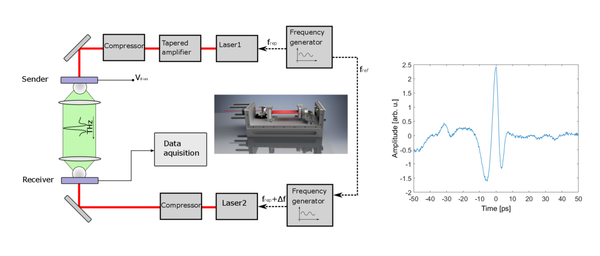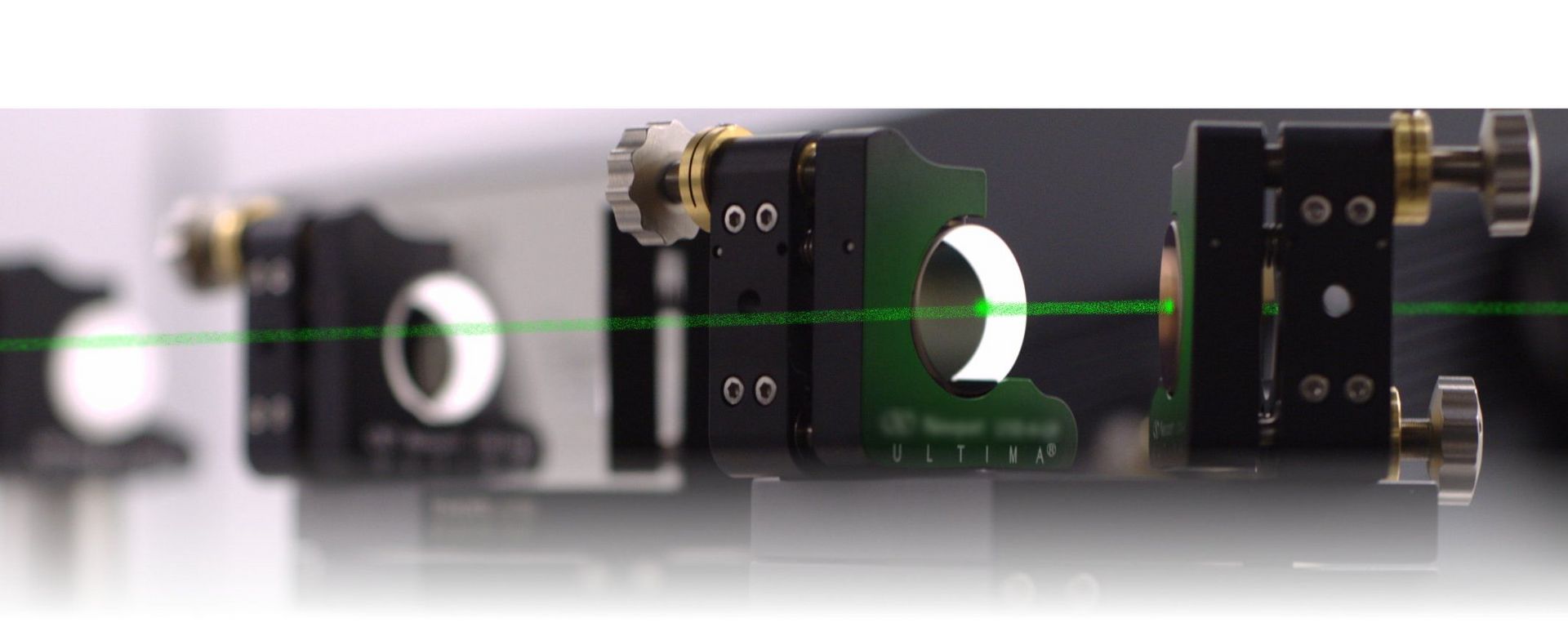Diode laser based THz generation
The so called 'THz gap' in the range of 100GHz to 10THz got its name from the difficulties to generate and detect electromagnetic radiation in the frequency range. Nonetheless there is a huge zoo of different approaches and techniques to realize measurement systems in this THz gap. The motivation to do so comes from the potential applications of the those systems.
When using photonics concepts the systems can be roughly categorized by the lasersystem which is used:
- Wavelength: The lasersystems for THz generation are typically either solid state lasers fiber lasers, or diode laser. Depending on the these systems different wavelength ranges for downconversion into the THz range can be accessed. In our group we work together with our partners with diode lasers in the ranges of 800nm and 1550nm.
- Modelocking: While modelocked lasers are used for TDS (Time Domain Spectroscopy), continuous wave (CW) lasers are used for FD (Frequency Domain) systems. Even a Quasi TDS operation is possible when a high number of uncorrelated CW modes are mixed. At our group we work on all three operation regimes for THz generation.
- Resonator: Diode lasers can be used as active medium inside a laser cavity or can be used as monolithic laser sources. While an external cavity configuration gives more flexibility, the development of specialised monolithic diode lasers is the best approach for compact and cost efficient laser systems.
Here is a short overview about some of the photonics THz concepts based on semiconductor lasers we work on at PTT:
THz systems with tunable monolithic Y-branch lasers
For future integration external cavity laser diode arrangements are not suitable because of their complexity. Therefore, we have analyzed monolithic two color diode lasers based on DBR (distributed Bragg reflector) and DFB (distributed feedback) laser architectures. This analysis started with Y-shaped double DBR-laser diodes provided by the Ferdinand Braun Institute (FBH). These lasers showed tunable two color operation and we successfully implemented them into a homodyne THz system for application in THz absorption and refractive index measurements. Though a proof of principle was successfully realized, the lasers provided several difficulties for the desired application in this project. First, they were designed for a center wavelength in the 0.8 µm range which is not compatible with the transmitter and receiver technology we use. Second, and more important, the lasers exhibit mode hops and imperfect tuning behavior which induces major challenges for THz measurement applications.

Therefore, in the next step, we investigated Y-shaped double DFB two color laser diodes based on InP technology, i.e. emitting in the 1.55 µm wavelength range. The lasers were provided by Sacher Lasertechnik and provided difference frequencies of around 0.8 THz and 1 THz which was continuously tunable over 50 GHz by variation of the injection currents. The lasers were implemented into a new THz homodyne system for the 1.55mm range based on components delivered by our new partner at TUDa. In successful proof-of-principle studies, we demonstrated THz thickness measurements with these devices.
Selected references:
- J. O. Gwaro, C. Brenner, L.S. Theurer, M. Maiwals, B. Sumpf, and M.R. Hofmann, “Continuous Wave THz System Based on an Electrically Tunable Monolithic Dual Wavelength Y-Branch DBR Diode Laser, J. of Infrared, Millimeter and Terahertz Waves, Feb. 2020.
THz systems based on modelocked diode lasers
In addition to the continuous wave (CW) THz systems discussed above, we have also studied modelocked diode laser systems for time domain spectroscopy (TDS). First, we have developed a THz TDS system based on asynchronous optical sampling of two external cavity modelocked laser diodes. The system setup as shown in the figure was successfully realized and its operation was verified but the realized bandwidth was below 0.3 THz due to electronic problems and timing jitter of the external cavity diode lasers.[9] Therefore, we have started to analyze different concepts for monolitically modelocked diode lasers that potentially enable integration into our THz systems. The stability of these single-chip devices has been and is still analyzed with respect to applications in THz-TDS systems and as frequency combs for CW THz systems.

Selected references:
- N. Surkamp, B. Döpke, A. Klehr, A. Knigge, G. Tränkle, M.R. Hofmann, “Diode laser based terahertz asynchronous optical sampling spectroscopy”, Semiconductor Integrated Optoelectronics (SIOE) Conference, Cardiff, Wales, UK, April 2017.
- B. Döpke, N. Surkamp, Y. Hu, C. Brenner, A. Klehr, A. Knigge, G. Tränkle, M.R. Hofmann, "Asynchronous sampling terahertz time-domain spectroscopy using semiconductor lasers", Electronics Letters, Apr 2018.
- C. Brenner, Y. Hu, J. Gwaro, N. Surkamp, B. Döpke, M. Hofmann, B. Kani, A. Stöhr, B. Sumpf, A. Klehr, and J. Fricke, "Near Infrared Diode Laser THz Systems", Adv. Radio Sci. 16, 1–9, April 2018.
Colleagues:
